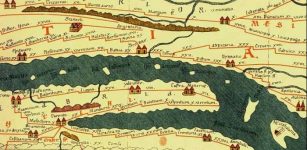Old Kingdom Mastaba Decorated With Rare Paintings Found In Dahshur Necropolis, Egypt
Conny Waters - AncientPages.com - A massive Old Kingdom mastaba featuring rare and beautiful paintings has been unearthed during an archaeological dig in the Dahshur necropolis, located about 15 miles south of Cairo, Egypt.
The excavations were carried out by a team from the German Archaeological Institute in Cairo.
Credit: Ministry of Tourism and Antiquities
The Dahshur complex is famous for its remarkable structures built during the Old Kingdom period, including pyramids, mortuary temples, and other buildings that are still waiting to be discovered.
Dahshour's most prominent landmarks include the Red Pyramid and the Bent Pyramid. These structures are believed to have been built by King Seneferu, the father of King Khufu, around 2650 B.C.
According to Dr. Stephan Seidlmayer, leader of the excavation team, preliminary studies of the mastaba suggest the tomb was constructed at the end of the Fifth or early Sixth Dynasty.
Dr. Seidelmeyer's archaeological mission at the site began in 1976. The initial excavations were primarily concentrated on the pyramids commissioned by King Sneferu, namely the Bent Pyramid and Red Pyramid from the Old Kingdom's 4th Dynasty, as well as King Amenemhat III's 'Black Pyramid' from the Middle Kingdom's 12th Dynasty.
Credit: Ministry of Tourism and Antiquities
In recent times, however, the mission has shifted its focus towards unearthing tombs of significant individuals such as officials, priests, and administrators from that era. It is noteworthy to mention that this site also houses remnants of King Amenemhat II’s White Pyramid along with its associated complex from the Middle Kingdom's 12th Dynasty.
As the research team explained, the mastaba is part of a vast cemetery belonging to the inhabitants of the Red Pyramid town.
Bent pyramid at Dahshur, Egypt. Credit: Adobe Stock - Nick Brundle
The inscriptions on a large limestone false door indicate that the mastaba tomb was the final resting place of a man named Seneb-nebef, who served in various administrative roles within the palace (khentiu-she), and his wife Idut, a priestess of Hathor and lady of the sycamore.
The practice of constructing "false doors" was prevalent in ancient Egypt. These mysterious doors were believed to serve as gateways to the underworld, according to traditional Egyptian beliefs. Known alternatively as "Ka doors," these structures were thought to enable the Ka - a component of the soul to traverse through them. Such architectural features became commonplace in mortuary temples and tombs from around the Third Dynasty and New Kingdom temples. The false door symbolized a crossing point between the mortal realm and that of gods and spirits. The ultimate goal for the soul was to reach the "Field of Reeds" or Aaru ("rushes") and enter the kingdom of Osiris.
Credit: Ministry of Tourism and Antiquities
This discovery distinguishes itself by its exceptional painted decoration, which is uncommon in Dahshur Necropolis, as noted by Seidlmayer. The intricate artwork portrays scenes from daily life, such as donkeys threshing grain, ships traversing the Nile River, and vibrant marketplaces. It also includes depictions of attendants presenting offerings.
Dr. Seidelmeyer emphasized that the mission will complete its excavations at the site, further stating that the forthcoming period will be dedicated to cleaning and documenting the cemetery and its inscriptions.
See also: More Archaeology News
The mission's significant discoveries include a tomb belonging to palace servants from Amenemhat II's era (Middle Kingdom, circa 1880 BC), a harbor facilitating Sneferu’s Bent Pyramid, a causeway connecting the two structures, and a ritual garden associated with the pyramid’s Valley Temple.
Written by Conny Waters - AncientPages.com Staff Writer
























